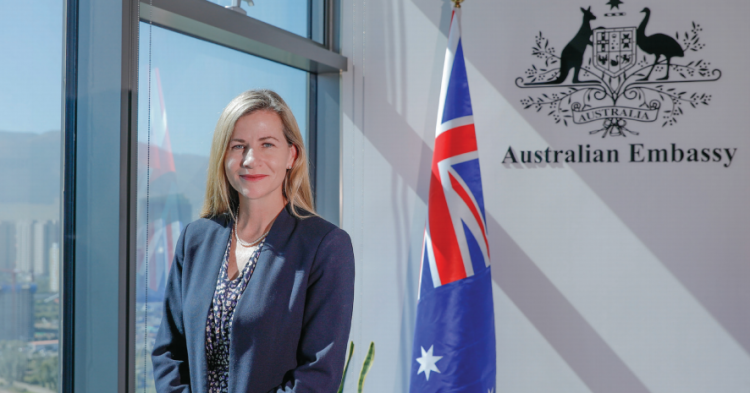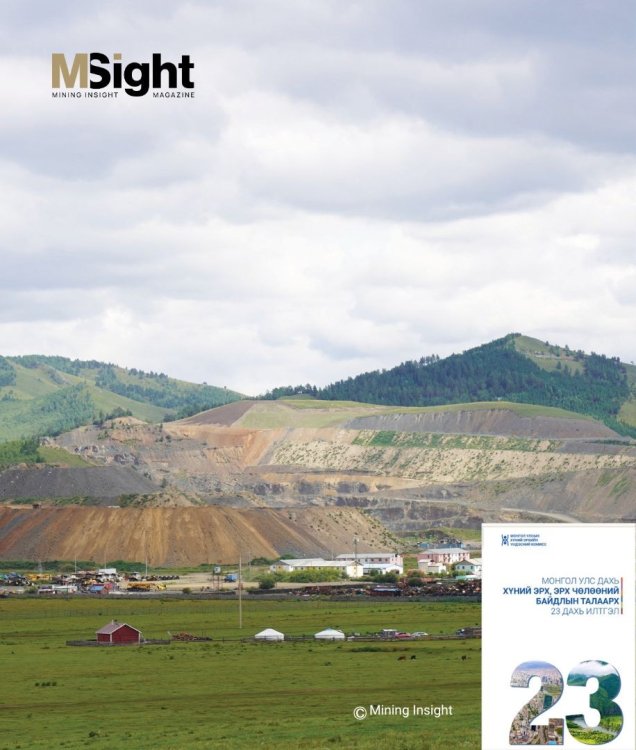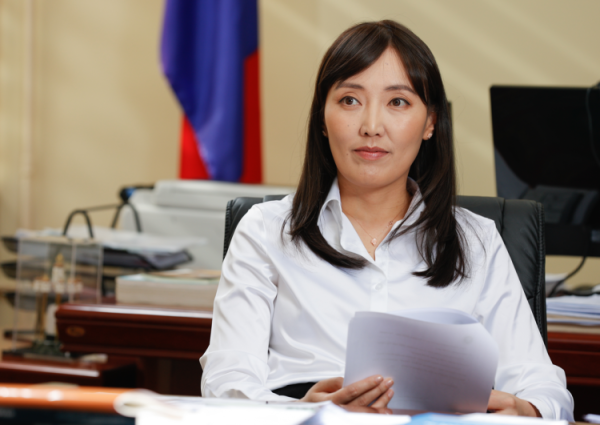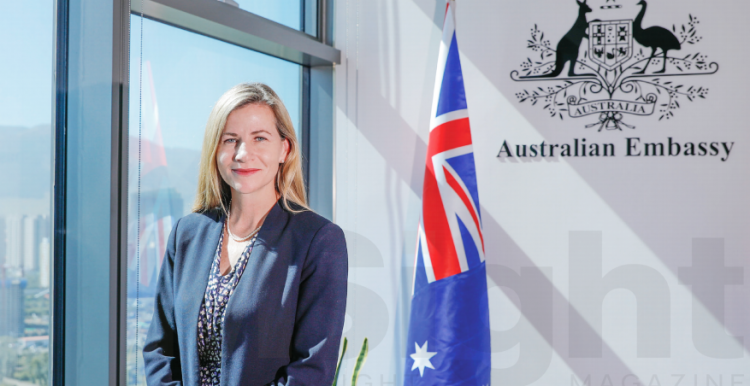 Mining Insight’s N.Ariuntuya spoke with Katie Smith, Ambassador Extraordinary and Plenipotentiary of the Commonwealth of Australia to Mongolia. Her Excellency the Ambassador presented her Credentials to the President of Mongolia on June 28. She is the first female Ambassador Extraordinary and Plenipotentiary of the Commonwealth of Australia to Mongolia.
Mining Insight’s N.Ariuntuya spoke with Katie Smith, Ambassador Extraordinary and Plenipotentiary of the Commonwealth of Australia to Mongolia. Her Excellency the Ambassador presented her Credentials to the President of Mongolia on June 28. She is the first female Ambassador Extraordinary and Plenipotentiary of the Commonwealth of Australia to Mongolia.Dear Ambassador, please introduce yourself to our readers. Please share your perception of Mongolia before your arrival and what your first impression was when you first arrived.
Thank you for interviewing me. It is such an honor to be serving as Australian Ambassador to Mongolia. I am only the third Australian resident Ambassador and the first female Ambassador here. I have worked for the Australian Department for Foreign Affairs for almost 20 years. Most of my focus has been working on Southeast Asian countries including Indonesia, the Philippines, Timor-Leste, and most recently, Laos. In those countries, I focused on managing the Australian Government development programs, particularly in the social sectors. In the last couple of years, my focus has been on Australia’s bilateral relationships with Pacific Island countries. This is my first time working in Northeast Asia and my first time being an Ambassador and I’m looking forward to deepening Australia’s relationship with Mongolia. Mongolia is very famous around the world, of course for Chinggis Khan. He is well-known for his achievements across the globe. The perception many Australians hold is that Mongolia is a wild and far-off land. But since being here, I have learned that Mongolia is extremely diverse and a lot more complex. The culture is deeply traditional, rich and diverse. Mongolians’ connection to the countryside, the animals, and the nomadic life is extremely important to them. Mongolians are very warm people. I’ve learned that hospitality is a very important part of the culture. It has been amazing for me to have that warm welcome. Mongolia is also a lot more modern and dynamic than I expected.
You have been appointed as Ambassador during the 50th anniversary of the establishment of diplomatic relations between Australia and Mongolia. How would you describe the economic and trade links between the two countries? What do you see as the next opportunity to further develop bilateral relations?
It is certainly a privilege to arrive at this milestone year. I see our bilateral relations at the moment as very strong and our relationship is in excellent shape. If we look over the last 50 years of our relationship, there have been some key milestones along the way. A key development was when Australia became a third neighbor with an expanded partnership with Mongolia in 2007. The opening of our embassies in each other’s country was a boost to our relationship. We have also had several high-level visits. One of the most outstanding ones was when our Governor General visited here in 1994. Since then, we have had many bilateral visits, including the visits of foreign ministers and the Prime Minister of Mongolia. Mongolia and Australia share a lot in common. We are both democratic countries, we have free market economies. We both value human rights. We value nternational rules and norms. We share a very strong bond in education. Thousands of Mongolians travel to Australia each year to study. We have a scholarship program that has been running for almost thirty years. We have very strong people-to-people linkages. In terms of our trade and investment linkages, this is in good shape but there is a lot of potential to grow our relationship. Our trade in services is strong, particularly in the mining sector. Part of my job here will be to explore trade opportunities, support companies to come here, and look for those investment projects. It’s in the interest of both countries. It helps Australian companies to expand and the development of Mongolia.
How will the 50th anniversary be held? Will there be any special events that we can expect?
This whole year is a celebration for us. We have a special anniversary grants program, which has provided funding to 10 organizations in Mongolia, focused on disability inclusion, gender equality, and community development. We have also held events including a launch in and other events with different organizations to mark the year. For example, last week, I joined a research conference with the Australian National University and the National University of Mongolia that focused on the 50th anniversary and looked at the relationship over time. We are hoping to hold a special cultural performance in the year to demonstrate the strong linkages between the countries. We are also very pleased to welcome Mongolia’s Deputy Prime Minister to Australia for a visit in September.
There are several Australia-invested, ASX-listed companies, and Mongolia-Australian joint ventures operating in Mongolia’s mining sector. How do you see business relations and bilateral trade between Australia and Mongolia including investments in the mining sector going forward? How much opportunity is there for more Australian investment in the Mongolian mining sector?
The latest statistics showed that about 60 Australian companies are operating here or have some sort of presence here. That is positive.
The Australian Trade Commission is part of our Embassy team. They are there to provide advice and market insight to Australian companies and have a large pipeline of Australian companies that want to invest here. To help Australian companies understand Mongolia, events like the Mining Week that Mongolia is running are important. We are supportive of the Mongolian Government’s Economic Recovery Policy. I think it will be a big help to increase foreign direct investment here, especially in the mining sector. Mongolia has an incredible endowment of natural resources. I think it is just a matter of time to develop those resources transparently and competitively. A strong judiciary, clear taxation system, and infrastructure are important. Skills are also important too. That is what Australia has been focused on through our work here. Beyond mining, there are opportunities to expand cooperation. For example, in the energy sector, there are already some companies that have started exploration in coalbed methane, which is showing great potential. Other Australian companies are interested in exploring green hydrogen, which is a very nascent area.
In terms of energy, both Australia and Mongolia have significant coal resources. But at a time when the global phase-out of coal is in full swing, and coal’s potential is limited, how is Australia making its energy transition?
You’ve rightly pointed out that both Australia and Mongolia are on the pathway to an energy transition. Australia, like Mongolia, is very dependent on coal-fired power plants for some time. Roughly 50-60 percent of power comes from coal for some time in Australia and around 25 percent comes from gas. Australia has a new commitment to reduce emissions by 43 percent by 2030. Alongside this, they have committed to achieving 82 percent of Australia’s energy production from renewables by 2030. It is an ambitious shift, but it is also one that is very achievable. The Australian Government knows that it isn’t going to happen by itself, but it needs incentives and investment. So, there is going to be a $20 billion investment to upgrade the grid so it takes in supply from renewables. We also need to invest in skills. So we are going to be making a large investment in apprenticeships in renewables. There are also going to be other subsidies and incentives, such as incentivizing Australians’ shift to electric vehicles away from petrol vehicles. It is going to be an exciting time and it also provides a lot of opportunities in the long term for employment and the cost of energy is going to decrease quite significantly for Australia too. I hope as Mongolia moves along its energy transition there will be a lot more opportunities for cooperation and investment here in this sector.
AUSTRALIAN COMPANIES ARE SHOWING INTEREST TO INVEST
IN METHANE GAS, HYDROGEN, AND RENEWABLE ENERGY PROJECTS
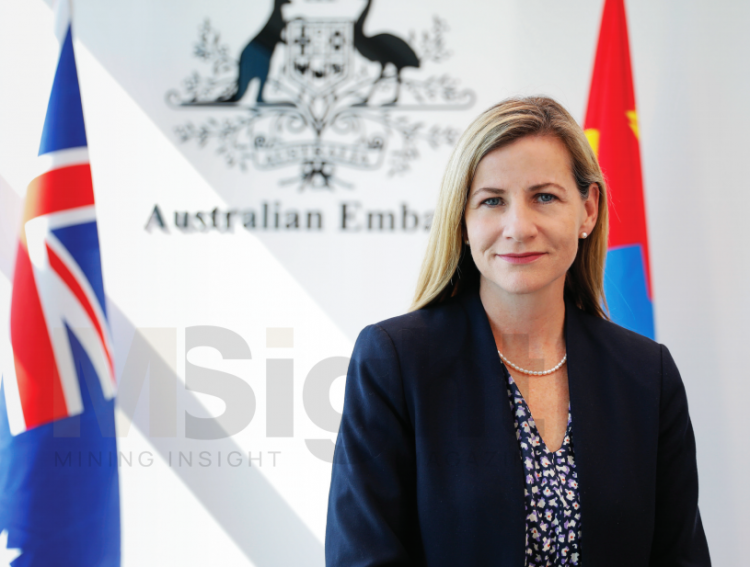 Our country intends to revise the Law on Minerals and protect the legal framework of “critical minerals”. Australia has extensive experience in mining and the management of critical minerals. Can you tell us a little about Australia’s experience in the critical mineral sector, the lessons that were learned, and Australia’s strategic concepts that will inform future policy? What should Mongolia focus on as it now just shifts its focus to this sector?
Our country intends to revise the Law on Minerals and protect the legal framework of “critical minerals”. Australia has extensive experience in mining and the management of critical minerals. Can you tell us a little about Australia’s experience in the critical mineral sector, the lessons that were learned, and Australia’s strategic concepts that will inform future policy? What should Mongolia focus on as it now just shifts its focus to this sector?Like Mongolia, Australia is highly endowed with critical minerals. Australia has a long tradition of mining, which has mostly focused on extraction. In the area of critical minerals, because there is going to be such a large increase in global demand, it is certainly an area where we have had a deliberate and targeted strategy.
It is also about downstream processing of those minerals and value-adding. Again, it takes government investment at multi-layers. A key area is the AUD 2 billion critical minerals facility that will help companies get started in the critical minerals area. It helps them to extract and invest in that area. Other elements of the strategy is a AUD1.3 billion manufacturing initiative, an accelerator initiative and research and development. The strategy is about investing and it is about helping things speed along by de-risking projects. I think this experience could be beneficial to Mongolia. I do think there will be some exchanges and some cooperation that we could put into place to support Mongolia to understand where Australia is going. Mongolia is in a position now that it can learn from other countries and open up for investment. For Australia, it requires a concerted effort. Parliament has to be on board. Government has to be on board. The government budget has to be dedicated and legislation and taxation need to be clear. In Australia, we’ve had quite strong investor confidence over many years, which has been due our good legal system and contract enforcement.
What are the main challenges and difficulties that Australian companies operating in Mongolia face today?
A positive side is that there are many Australian companies here. They already have exploration licenses; some are already developing the mines. I’ve used my two months here to get out to meet as many people as I can to learn about the environment. Australian companies have been fairly positive so far. The people, the human resources, and the capabilities are high. The innovation and ingenuity of the people are strengths here in Mongolia. We did hear from some companies about the corruption perception index. We know that Mongolia has a plan to improve this situation which will help investor confidence. Concrete action such as the shift to E-Government and increasing transparency, looking at the minerals law again, are going to encourage more investment here in the mining sector.
When talking about cooperation in the mining sector of the two countries, we cannot leave out the Oyu Tolgoi project, which is almost a joint venture between the two countries. Could you give your opinion on what the parties should prioritize for the sustainable and successful implementation of the Oyu Tolgoi underground mining project?
Oyu Tolgoi is going to be an important investment for both of our countries. We all want it to reach its full potential. What’s important about that investment is to make sure of its transparency on both sides. It is important to understand the arrangements, including royalties and taxes are expected. Regulations of the country need to be very strong, as do relationships with the company. For me, this is what the Australian companies bring to the sector globally. High standards of environmental and social responsibility are critical. The cultural heritage side is also important. Also, we should not overlook the skill side of it and ensure employment of local people, and do skills transfer and upgrading.
You’ve mentioned cooperation in energy and agriculture areas. How do you see the opportunities in agriculture?
In terms of agriculture, there is more potential here for cooperation and investment. On the cooperation side, first of all, we are focusing on our development program. As you know, we’ve had an Australia-Mongolian Extractives Program here. It focuses on helping the equitable distribution of those resources. In the past, we’ve had the Australian International Agricultural Research Centre undertake cooperation with Mongolian Research Institutes on grassland management and looking at incentives for better management of livestock. One of my priorities is to see if we can do some more programs in agricultural cooperation as Australia has extensive experience in farming, particularly in dryland farming that may be useful to the Mongolian conditions. One niche area that we’ve started is sheep shearing. Australia has a long tradition of wool export. We are supporting a training pilot on sheep shearing here to introduce different techniques here. This activity will also benefit Australia as we will be able to bring skilled Mongolian sheep farmers to Australia to work on our farms during the off-season. One of our milestones in the 50th anniversary is a new Work and Holiday Maker visa, which started on 1 July. It allows young Mongolians to come to Australia to work and holiday and young Australians to come here. We have a lot of worker shortages in our agricultural industry so we need to bring in seasonal labour. Hopefully we can expand this program in the future. This is just one example of bringing synergy between sectors of our economy.
When I looked at the meetings you held after being appointed as an ambassador, I noticed that you met with the National Gender Committee. I take it that gender equality is on your priority list.
It is such an incredible opportunity to be Australia’s first female Ambassador to Mongolia. I was amazed to see the strength of Mongolian women, they are well-educated, hardworking and make such a big contribution to the Mongolian economy. It is wonderful to see that and to see that we can be strong partners. But I have learned there are still challenges, including around women’s political representation. I think there is certainly an area that we can work together on. The other key area is violence against women. That is certainly a big challenge, not only is this a social challenge, but it is also an economic one. Australia has grants programs here to progress gender equality and support advocacy. The change needs to happen at every level of society, starting with children. as it permeates every part of society. The other important thing is to mainstream gender equality in everything we do. Development programs such as the Australia and Mongolia Extractives Program mainstream gender through the program. One of the key achievements was to support the Ministry of Mining to deliver online gender training modules, specifically targeted at the extractives sector. We are talking about the mining sector and how it is addressing these issues, and empowering women. We don’t just want the numbers. We want women to be decision-makers and ministers as well. It is about women having voices and making sure that women feel like they are being heard.
Mining Insight Magazine, №07,08 (008,009)



